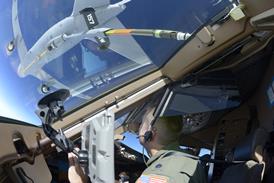Saab Avitronics says it is finished development work of a new low-cost head-up display for fixed- and rotary-wing business aircraft, the first of several new HUDS from manufacturers attempting to bring a more affordable landing and situational awareness aid into a broader swath of the business aviation community.
The Saab system, called Rig, is to cost roughly $50,000 uninstalled, a price HUD manufacturers generally point to as the threshold for what is considered low-cost. Although the company does not yet have a launch customer, it is continuing flight testing in a helicopter, says Johan Zanden, Saab senior marketing and sales executive. Zanden would not discuss details of how the system operates and noted that the final size of the HUD will be a function of the particular aircraft in which it is installed.
HUD providers Elbit Systems of America and BAE Systems are also working on lower-cost versions of their systems as well and are looking for launch customers.
Elbit has two development programmes, one that moves away from traditional glass optics for plastic and would sell for roughly $50,000, and another LCD-based HUD that uses more traditional features and costs $120,000-150,000.
Development work on the low-end system, however, has been slowed to focus on the more expensive advanced technology HUD (AT-HUD), Elbit's first "soup-to-nuts" HUD, says Edward Popek, sales and marketing manager.
AT-HUD is designed specifically for gaining lower instrument landing minimums in conjunction with an enhanced flight vision system (EFVS). Elbit is teamed with its EFVS aftermarket distributor Jetcraft to certificate the system on a Challenger 604, a programme that is due to be complete in March 2010.
Jetcraft is also sells Elbit's EVS II EFVS and will install the total system under a supplemental type certificate to be completed next year. The installed price will be roughly $1 million for the combined system.
BAE's Q-HUD will cost "significantly less" than $1 million installed and is on track for a late 2010 entry into the market, say officials. The system, which does not use the glass optics of legacy systems to present the information, has a smaller profile and smaller fit, allowing it to be incorporated into smaller aircraft. The company has not yet secured a launch customer for forward-fit applications, but says it will complete the system on its own if required.
Source: Flight International























